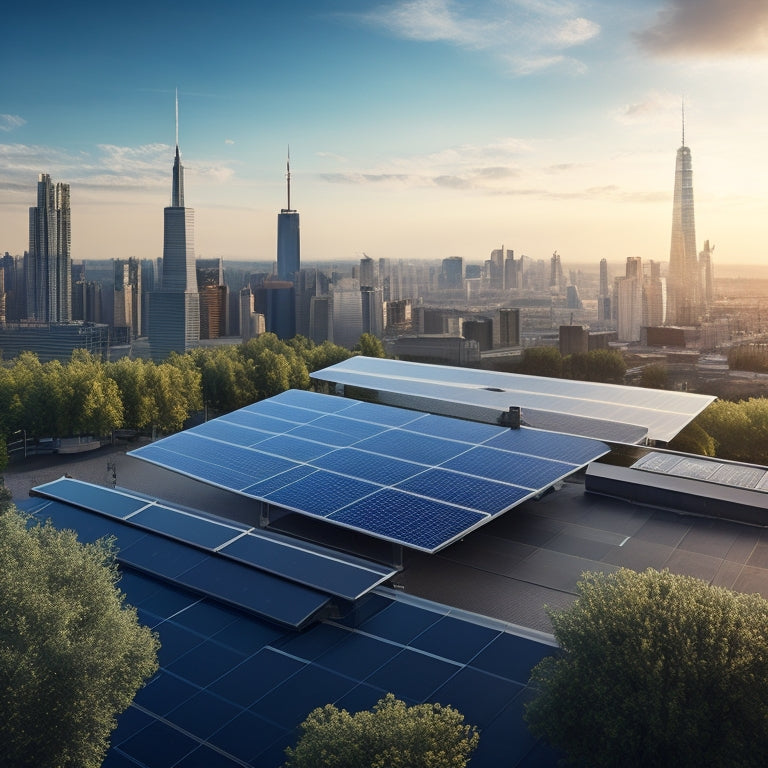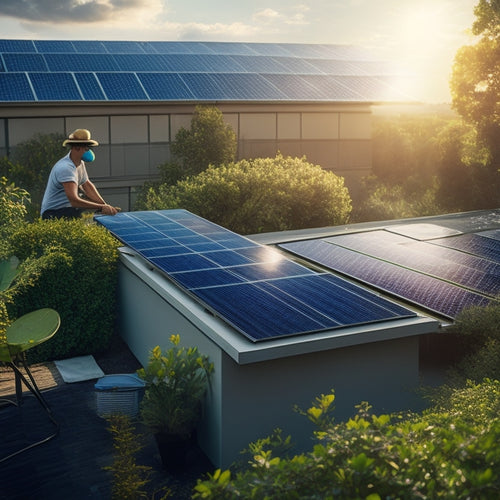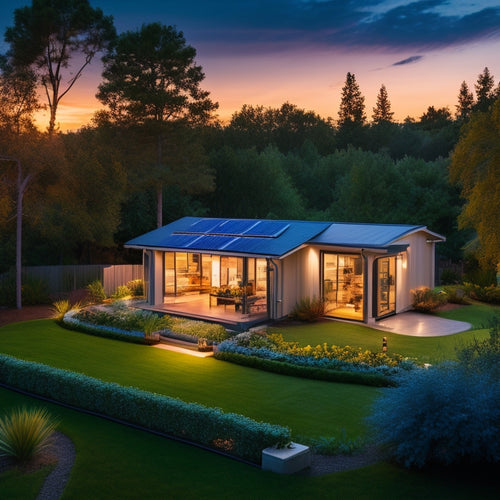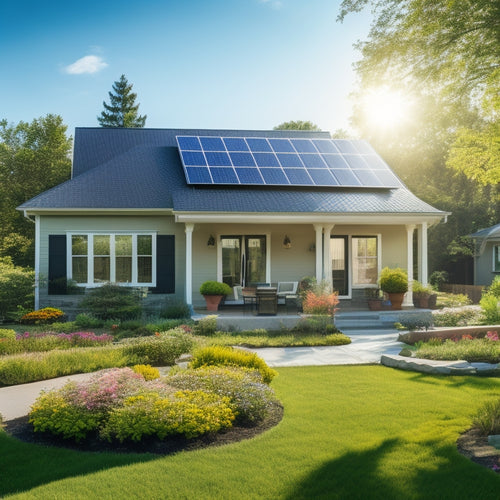
What to Know Before Installing Commercial PV Panels
Share
Before installing commercial PV panels, you'll need to assess your energy needs by analyzing consumption patterns and peak usage times. You'll also need to guarantee compliance with local building codes, evaluate your roof's condition and suitability, and determine the best panel orientation and tilt. Choosing the right panel type and system size, as well as considering energy storage options, are also essential. Additionally, you'll need to traverse permitting and inspection requirements, and budgeting and financing options. By understanding these key factors, you'll be well-prepared to initiate a successful commercial PV panel project that meets your energy goals and financial expectations - and there's more to investigate in the process.
Key Takeaways
- Assess energy consumption patterns and peak usage times to determine the appropriate system size for your commercial PV panel installation.
- Ensure compliance with local building codes, permits, and regulations to avoid costly rework and safety hazards.
- Evaluate your roof's condition, material, and orientation to determine its suitability for PV panel installation.
- Choose the right panel type, considering factors like efficiency, durability, and warranty, to maximize energy production and ROI.
- Consider financing options, including cash purchase, loans, and PPAs, to determine the best approach for your commercial PV panel project.
Assessing Your Energy Needs
Before investing in a commercial photovoltaic (PV) panel system, you need to assess your energy needs to determine the ideal system size and configuration. This involves conducting an energy consumption analysis to identify your facility's energy usage patterns.
You'll need to gather historical energy consumption data to understand your energy usage habits, including the time of day, week, and month when your energy consumption peaks.
A peak demand assessment is also essential to determine the maximum amount of energy your facility requires at any given time. This helps you size your PV system accurately to meet your energy demands during peak periods.
You should consider factors such as the type and number of electrical loads, lighting schedules, and HVAC system operation. By analyzing your energy consumption patterns and peak demand, you can determine the best system size, configuration, and component selection for your commercial PV panel system.
This guarantees that your system operates efficiently, reducing your energy costs and environmental impact.
Understanding Local Building Codes
You'll need to guarantee your commercial PV panel installation meets local building codes, which involve code compliance requirements that vary by jurisdiction.
These requirements dictate the minimum standards for designing, installing, and inspecting PV systems, and non-compliance can result in costly rework or even system shutdown.
Additionally, you'll need to take into account zoning ordinance restrictions that may impact system placement, size, and aesthetics.
Code Compliance Requirements
Three key aspects of local building codes must be considered when planning a commercial PV panel installation: electrical, building, and fire codes.
You'll need to guarantee your installation meets electrical codes, which cover wiring, grounding, and connections. This includes adherence to installation standards, such as securing panels to the roof and providing clear labeling.
Building codes, on the other hand, focus on structural integrity, including weight distribution and roof load calculations. Fire codes are also essential, as they dictate clearances, access paths, and firefighting requirements.
You must comply with these codes to guarantee a safe and functional PV system. Failure to do so can result in serious safety hazards, fines, and even system shutdown.
Furthermore, compliance with local codes is often a requirement for obtaining permits and connecting to the grid. You should familiarize yourself with the specific codes and regulations in your area, as they may vary.
Zoning Ordinance Restrictions
Local zoning ordinances can greatly impact the feasibility of your commercial PV panel installation, as they dictate how property can be used and developed. Before installing your commercial PV panels, it's crucial to understand the local zoning ordinances that govern your property.
Zoning ordinances can affect your installation in various ways, including:
| Zoning Aspect | Impact on Commercial PV Installation | Considerations |
|---|---|---|
| Setback regulations | Affects panel placement and size | Confirm compliance with minimum setbacks from property lines |
| Zoning classifications | Determines allowed land uses | Verify that solar installations are permitted in your commercial district |
| Land use | Influences panel placement and orientation | Consider nearby land uses that may impact solar access |
| Noise restrictions | Regulates noise levels during installation and operation | Make sure that your installation meets noise standards |
| Aesthetic guidelines | Impacts panel design and visibility | Comply with local aesthetic standards to avoid visual pollution |
Understanding these zoning ordinance restrictions will help you maneuver the installation process smoothly and avoid potential roadblocks. Be sure to research and comply with local regulations to guarantee a successful commercial PV panel installation.
Evaluating Roof Condition and Suitability
Evaluating your roof's condition and suitability is a critical step in the commercial PV panel installation process, as it directly impacts the system's performance, longevity, and overall return on investment.
You'll want to verify your roof can support the weight and stress of the PV panels, as well as provide a secure and watertight seal.
When evaluating your roof's condition, consider the following key factors:
-
Roof material assessment: Is your roof made of a compatible material, such as asphalt shingles, metal, or concrete? Some materials, like clay tiles or slate, may be too brittle or heavy for PV panels.
-
Structural integrity evaluation: Can your roof support the additional weight of the PV panels, including the weight of snow and wind loads?
-
Age and condition of the roof: Is your roof nearing the end of its lifespan or showing signs of wear and tear?
-
Obstacles and shading: Are there any obstructions, such as skylights, vents, or tree branches, that could block sunlight or hinder panel installation?
-
Local building codes and regulations: Are there any specific requirements or restrictions in your area that may impact your roof's suitability for PV panels?
Determining Panel Orientation and Tilt
Once you've confirmed your roof can support a commercial PV panel installation, it's time to evaluate the ideal orientation and tilt of your panels. This is essential because it directly impacts energy production.
The best tilt and orientation of your panels depend on your location's solar azimuth, which is the direction from which the sun's rays hit the Earth. In the northern hemisphere, a south-facing orientation is generally best, as it receives the most sunlight throughout the year.
However, this can vary depending on your location and the surrounding environment. For instance, if your roof is partially shaded or has obstructions, you may need to adjust the orientation and tilt of your panels to maximize energy production.
The best tilt angle also varies by latitude, with more northern locations requiring a steeper tilt to capture more sunlight during the winter months. By carefully evaluating these factors, you can guarantee your commercial PV panels are installed at the ideal orientation and tilt to maximize energy production and return on investment.
Selecting the Right Panel Type
Your commercial PV panel installation's performance hinges on selecting the right panel type, which can be a challenging task given the numerous options available.
With so many options, it's crucial to understand the key differences between panel types to make an informed decision.
When selecting the right panel type, consider the following factors:
-
Panel efficiency: Look for panels with high efficiency ratings, usually above 20%, to maximize energy production per unit area.
-
Technology advancements: Consider panels with advanced technologies, such as bifacial or PERC (Passivated Emitter and Rear Cell) technology, which can increase energy output and durability.
-
Durability and warranty: Assess the panel's durability and warranty offered by the manufacturer, guaranteeing your investment will last for years to come.
-
Cost and budget: Evaluate the cost of different panel types and balance it with your budget, considering the overall cost-benefit analysis.
-
Certifications and compliance: Verify that the panel type meets local and international certifications, such as UL and IEC, to confirm compliance with safety and performance standards.
Sizing Your Commercial PV System
Having selected the right panel type, you can now focus on sizing your commercial PV system to maximize energy production and meet your specific energy needs.
The system capacity you choose will directly impact your energy efficiency and return on investment. It's crucial to evaluate your load management strategy and determine the ideal system size to match your energy usage patterns.
Larger systems can provide more energy, but they also increase installation costs and maintenance considerations. You'll need to weigh these factors against the benefits of utility incentives and the positive environmental impact of generating clean energy.
Additionally, assess the project timelines and contractor selection, as these can affect the overall cost and efficiency of your installation.
Considering Energy Storage Options
Reliability is key when it comes to powering your commercial operation, and energy storage options can play a significant role in guaranteeing a stable and efficient supply of electricity.
As you consider installing commercial PV panels, it's vital to think about how you'll store excess energy generated during the day for use during periods of high demand or when the sun isn't shining.
When evaluating energy storage options, consider the following:
-
Battery Technology: Advances in battery technology have made energy storage more efficient and cost-effective. Look for batteries with high depth of discharge (DOD) and long lifetimes to maximize your investment.
-
Hybrid Systems: Hybrid systems combine different energy sources, such as solar and diesel generators, to provide a reliable and efficient supply of electricity. These systems can be customized to your specific energy needs and provide backup power during outages.
-
Scalability: Choose an energy storage system that can scale with your growing energy needs. This will guarantee you can store excess energy as your operation expands.
-
Integration: Confirm your energy storage system can seamlessly integrate with your existing electrical infrastructure and PV system.
-
Monitoring and Control: A strong monitoring and control system is vital for optimizing energy storage and confirming your system operates efficiently.
Permitting and Inspection Requirements
When installing commercial PV panels, you'll need to maneuver the permitting and inspection process, which involves submitting a permit application to your local authority, guaranteeing you meet the required inspection scheduling timeline, and verifying that your system complies with local building codes and regulations.
Failing to comply with these requirements can result in costly delays or even project cancellation.
Permit Application Process
Streamlining the permit application process is essential to guarantee a smooth installation of commercial PV panels.
You must ascertain that all necessary permits and approvals are obtained before commencing the installation. This process involves submitting a detailed application package to the relevant authorities, which includes:
- A detailed site plan, highlighting the location and layout of the PV panels, electrical infrastructure, and other relevant components
- An environmental impact assessment, evaluating the potential effects of the installation on the surrounding ecosystem
- Electrical and structural drawings, specifying the system's design and configuration
- A project timeline, outlining the installation schedule and key milestones
- A copy of your contractor's license and insurance certificates, verifying their qualifications and liability coverage
Inspection Scheduling Timeline
Schedule inspections strategically to avoid costly delays and guarantee a smooth installation of your commercial PV panels. You'll need to plan inspections at critical stages of the installation process to ascertain compliance with local building codes and regulations. Typically, inspections are required at the following stages: pre-construction, post-construction, and final inspection.
Determine the inspection frequency based on the complexity and size of your project. For larger installations, you may need to schedule more frequent inspections to ascertain that the work is progressing as planned.
Create an inspection checklist to ascertain that all necessary components are inspected and approved. This checklist should include items such as electrical connections, mounting systems, and panel installation.
It's essential to coordinate with your local building authority to schedule inspections at the required stages. Be prepared to provide documentation and access to the installation site as needed.
Code Compliance Checks
Your commercial PV panel installation project requires careful planning to secure code compliance, and for that, you'll need to maneuver through the intricate terrain of permitting and inspection requirements.
This involves making certain your project meets local and national safety regulations, electrical standards, and environmental impact guidelines. Failure to comply can result in costly rework, project delays, or even system shutdowns.
To promote a smooth installation process, consider the following key aspects of code compliance checks:
-
Permitting requirements: Obtain necessary permits from local authorities, including electrical, building, and zoning permits.
-
Installation guidelines: Adhere to industry-accepted installation practices, such as those outlined in the National Electric Code (NEC).
-
System performance: Make certain your PV system meets performance standards, including those related to system efficiency and energy output.
-
Utility interconnection: Comply with utility company requirements for grid connection, including application and approval processes.
-
Financing incentives: Research and comply with requirements for government incentives, such as tax credits or grants, that may impact your project's financial viability.
Budgeting and Financing Options
You'll need to determine how much you can afford to invest in commercial PV panels and investigate financing options to cover the remaining costs. Budget considerations play a critical role in the planning and installation process. As you plan your commercial PV panel project, consider the upfront costs, including the cost of the panels, installation, and maintenance.
| Financing Option | Description |
|---|---|
| Cash Purchase | Pay the full amount upfront, providing full ownership and no debt |
| Loan Financing | Borrow money from a lender, repaying the loan with interest |
| Power Purchase Agreement (PPA) | Partner with a third-party provider, purchasing electricity at a fixed rate |
| Lease Agreement | Rent the PV system, paying a monthly fee for a set term |
| Tax Incentives | Take advantage of government incentives, such as tax credits or grants, to offset costs |
When evaluating financing options, consider factors like interest rates, repayment terms, and contract duration. It's crucial to carefully weigh the pros and cons of each option to guarantee the best fit for your business needs and budget. By understanding your budget and financing options, you can make informed decisions and optimize your commercial PV panel installation.
Frequently Asked Questions
Can I Install Commercial PV Panels on a Leased Building?
You'll need to review your leasing agreements to guarantee they permit commercial PV panel installation, and assess the roof's integrity to determine if it can support the added weight and potential structural modifications required.
How Do I Handle Snow and Ice on Commercial PV Panels?
You'll need to address snow accumulation and ice removal proactively, ensuring your commercial PV panels remain efficient; consider installing snow-load-rated panels, using snow-raking systems, and performing regular ice removal to maintain peak energy production.
Are There Any Tax Credits for Commercial PV Panel Installations?
You'll benefit from federal incentives, like the Solar Investment Tax Credit (ITC), and state rebates, which can greatly reduce your commercial PV panel installation costs, making your investment more attractive and profitable.
Can I Use Existing Electrical Infrastructure for Commercial PV Panels?
As you traverse the electrical environment, think of your existing infrastructure as a riverbed, awaiting the waters of renewable energy. You'll need to assess compatibility and perform an infrastructure assessment to guarantee a seamless flow of power, determining if your electrical setup can handle the new commercial PV panels.
Do I Need Liability Insurance for Commercial PV Panel Installations?
You'll need liability insurance to protect yourself from installation risks, covering damages, injuries, and errors; insurance requirements vary by region, so you'll need to research and obtain the necessary coverage before starting your commercial PV panel installation project.
Conclusion
Before flipping the switch on your commercial PV panel installation, remember that "an ounce of prevention is worth a pound of cure." By carefully evaluating your energy needs, understanding local building codes, and reviewing roof condition, you'll set yourself up for success. Don't overlook vital details like panel orientation, system sizing, and energy storage options. With careful planning, you'll utilize the power of solar energy efficiently and effectively, reaping long-term benefits for your business.
Related Posts
-

Green Ways to Maintain Solar Panels
To maintain your solar panels sustainably, start with regular inspections to catch potential issues early, enhancing ...
-

Solar Power Backup Solutions During Outages
Solar power backup solutions guarantee you have reliable energy during outages, providing essential power when the gr...
-

Affordable Solar Panels for Home Use
Affordable solar panels offer you a smart way to cut down on energy costs while promoting sustainability. With govern...


